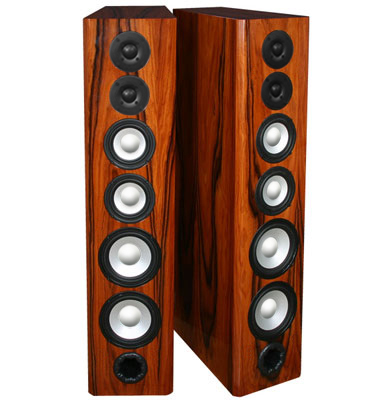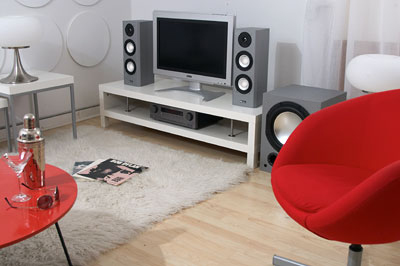
M80 Floor Standing Speakers in High Gloss Rosewood
It’s always a perplexing audio question to newcomers and to experienced home theater and stereo enthusiasts alike: Which type and size of loudspeaker do you go for? The compact and easily placed “bookshelf” speaker (small enough to fit onto or be supported by a typical bookshelf) or the relatively large floor standing speaker, which no matter the size, is still going to occupy some floor space because, well, duh, it stands on the floor! And it’s inevitably going to make its presence known as a piece of furniture.
Here’s a simple guide to making the choice between floor standing and bookshelf speakers easier.
- Floor standing speakers will always have deeper and greater bass output because of the size of the “box” or enclosure than will small bookshelf models. You cannot fight the physics of speaker design. Other things being equal, the bigger the box, the greater the bass output; the smaller the enclosure, the less deep bass will issue from it. So if you desire the deep rich low tones of an orchestra, a jazz group, or the driving rhythms of a rock band or pop group, then floor standing speakers should be the ones for you.
- BUT—and this is important—you can always add a separate powered subwoofer—a larger box with its own internal amplifier for only the deepest bass tones, to a couple of good bookshelf speakers like Axiom M22 v3s or M2 v3s, and you’ll get powerful bass as deep (or perhaps even deeper!) as a couple of big floor standing speakers produce. The trade-off is the third box in the room—the subwoofer, which you can hide behind a couch or plant in the corner.
- Floor standing speakers generally have more drivers (a woofer for deep bass, a midrange for the bulk of instrumental and vocal sounds, and a tweeter for high frequency nuances like cymbals and percussion instruments). Many floor standing speakers have as many as six drivers, like the Axiom M80 v3’s. Consequently, they will generally play much louder and more realistically in big rooms than a small bookshelf speaker, which is almost always a 2-way design (one woofer/midrange driver, and one tweeter).

That said, for many average-sized rooms, a good bookshelf speaker mated with a subwoofer will do a remarkably fine job so long as you dont have cathedral ceilings, “great rooms” of the Texas variety, and want ear-bending volume levels of heavy metal. Bookshelf speakers also have more spousal appeal—they can “disappear” into the décor, unlike floor standing speakers, which by definition, are furniture and are sometimes rejected by décor-conscious partners. To alleviate the latter objections, floor standing speakers can be quite beautiful when ordered in gorgeous wood veneers and finishes and hence blend in with the furniture in the room.






